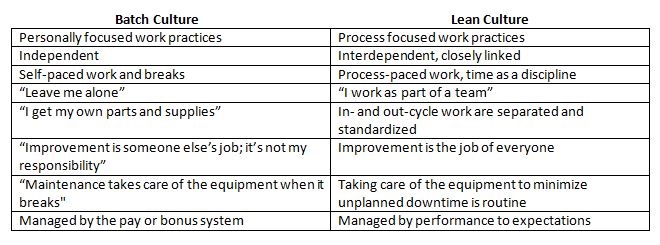How do manufacturers recognize culture?
Culture is invisible; it’s the “way we do things.” However, recognizing work culture in a manufacturing environment is essential for Lean production processes. For instance, culture allows employees to work on autopilot during the day, because it is a collection of habits and practices carried throughout a manufacturing company.
According to Creating a Lean Culture: Tools to Sustain Lean Conversions by David Mann, culture differences between a batch and Lean culture include:

Manufacturers that wish to “break” batch culture habits need to practice habits that make the workday more efficient. For instance, to achieve a Lean culture, manufacturers need to stop:
• Keeping a quantity of extra material, for “just in case.”
• Reordering more than needed when handling shortages, just to be sure you get enough.
• Always keeping the production line full in case something goes wrong.
• Starting a task early when information is not available from the upstream department.
• Leaving improvement process to the “experts.” Improvement strategies should begin with employees working
on the shop floor.
• Continue working around a problem instead of solving it immediately, consequently, pushing off the problem.
Likewise, manufacturer’s implementing Lean culture habits need to make sure they don’t slip back into old habits. If a manufacturer stops following through Lean habits, they will soon face unstable and out-of-control processes that will require reinstituting Lean habits all over again. Therefore, get your entire team on board, work together, and create a better culture as one.
Interested in Lean manufacturing principles?
Read our blog post, 4 Top Misconceptions on Lean Manufacturing.




